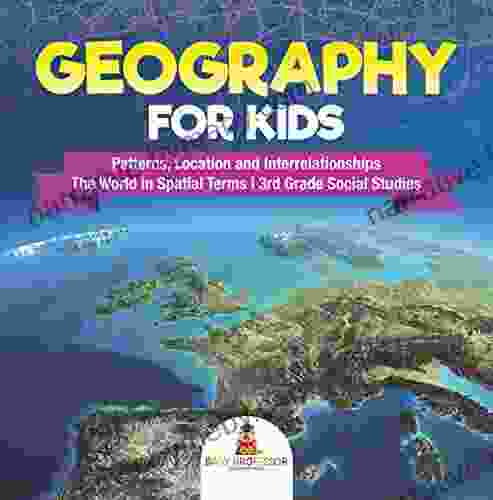Geography for Kids: Patterns, Location, and Interrelationships - The World In

Geography is the study of the Earth's surface and its human and natural features. It is a fascinating subject that can teach us a lot about the world around us. One of the most important aspects of geography is understanding patterns. Patterns can be found in the distribution of land and water, in the climate and weather, and in the distribution of plants and animals.
4.6 out of 5
| Language | : | English |
| File size | : | 4812 KB |
| Screen Reader | : | Supported |
| Print length | : | 32 pages |
Patterns in the Distribution of Land and Water
The Earth's surface is made up of about 70% water and 30% land. The water is distributed in oceans, seas, lakes, and rivers. The land is distributed in continents and islands.
The continents are large land masses that are surrounded by water. There are seven continents: North America, South America, Europe, Asia, Africa, Antarctica, and Australia. The continents vary in size, shape, and climate.
The oceans are large bodies of salt water that cover most of the Earth's surface. There are five oceans: the Pacific Ocean, the Atlantic Ocean, the Indian Ocean, the Arctic Ocean, and the Southern Ocean. The oceans vary in size, depth, and temperature.
The distribution of land and water on the Earth's surface has a major impact on the climate and weather. The oceans help to regulate the Earth's temperature, and they also provide a source of moisture for the atmosphere. The continents block the flow of air and water, which can create different climate zones.
Patterns in the Climate and Weather
The climate is the average weather conditions in a particular area over a long period of time. The weather is the day-to-day conditions of the atmosphere in a particular area.
The climate is influenced by a number of factors, including latitude, altitude, distance from the ocean, and prevailing winds. Latitude is the distance north or south of the equator. Altitude is the height above sea level. Distance from the ocean can affect the amount of moisture in the air. Prevailing winds are the winds that blow most frequently in a particular area.
The weather is influenced by a number of factors, including temperature, humidity, precipitation, and wind. Temperature is the measure of the warmth or coldness of the air. Humidity is the amount of water vapor in the air. Precipitation is the water that falls from the sky in the form of rain, snow, sleet, or hail. Wind is the movement of air.
The climate and weather can have a major impact on the distribution of plants and animals. Some plants and animals can only survive in certain climate zones. For example, tropical rainforests are found in areas with warm temperatures and high humidity. Deserts are found in areas with hot, dry climates.
Patterns in the Distribution of Plants and Animals
The distribution of plants and animals on the Earth's surface is influenced by a number of factors, including climate, soil, and water. Climate is the most important factor in determining the distribution of plants and animals.
Some plants and animals can only survive in certain climate zones. For example, tropical rainforests are home to a wide variety of plants and animals that cannot survive in colder climates. Deserts are home to a wide variety of plants and animals that can survive in hot, dry climates.
Soil is also an important factor in determining the distribution of plants and animals. Some plants can only grow in certain types of soil. For example, some plants can only grow in acidic soil, while others can only grow in alkaline soil.
Water is also an important factor in determining the distribution of plants and animals. Some plants and animals can only survive in areas with access to water. For example, some plants can only grow in wetlands, while others can only grow in dry areas.
The distribution of plants and animals on the Earth's surface has a major impact on the human population. Plants and animals provide us with food, clothing, and shelter. They also help to regulate the climate and water cycle.
Geography is a fascinating subject that can teach us a lot about the world around us. By understanding the patterns in the distribution of land and water, the climate and weather, and the distribution of plants and animals, we can learn more about how the Earth works and how we can live in harmony with it.
4.6 out of 5
| Language | : | English |
| File size | : | 4812 KB |
| Screen Reader | : | Supported |
| Print length | : | 32 pages |
Do you want to contribute by writing guest posts on this blog?
Please contact us and send us a resume of previous articles that you have written.
 Book
Book Novel
Novel Page
Page Chapter
Chapter Text
Text Story
Story Genre
Genre Reader
Reader Library
Library Paperback
Paperback E-book
E-book Magazine
Magazine Newspaper
Newspaper Paragraph
Paragraph Sentence
Sentence Bookmark
Bookmark Shelf
Shelf Glossary
Glossary Bibliography
Bibliography Foreword
Foreword Preface
Preface Synopsis
Synopsis Annotation
Annotation Footnote
Footnote Manuscript
Manuscript Scroll
Scroll Codex
Codex Tome
Tome Bestseller
Bestseller Classics
Classics Library card
Library card Narrative
Narrative Biography
Biography Autobiography
Autobiography Memoir
Memoir Reference
Reference Encyclopedia
Encyclopedia Pamela Lewis
Pamela Lewis Austin M Francis
Austin M Francis Ashutosh Jaiswal
Ashutosh Jaiswal Ashley Emma
Ashley Emma Barbara Katz
Barbara Katz Arthur Turrell
Arthur Turrell Becky Hall
Becky Hall B B Thatcher
B B Thatcher Janet Wood
Janet Wood Azel Ames
Azel Ames Isaac Fitzsimons
Isaac Fitzsimons Snorri Sturluson
Snorri Sturluson Ken Nakatani
Ken Nakatani Martin L Kutscher
Martin L Kutscher Kenneth P Miller
Kenneth P Miller Prerna Lal
Prerna Lal Giuseppe Cristiano
Giuseppe Cristiano Yair Zakovitch
Yair Zakovitch Ellen Schwartz
Ellen Schwartz Kate Parham Kordsmeier
Kate Parham Kordsmeier
Light bulbAdvertise smarter! Our strategic ad space ensures maximum exposure. Reserve your spot today!

 Chance FosterRevolutionize Education: "The Four Hour School Day" eBook Unlocks the Secrets...
Chance FosterRevolutionize Education: "The Four Hour School Day" eBook Unlocks the Secrets...
 Charles BukowskiPass Your Wisconsin CDL Test Guaranteed: Master the 100 Most Common Questions
Charles BukowskiPass Your Wisconsin CDL Test Guaranteed: Master the 100 Most Common Questions Maurice ParkerFollow ·16k
Maurice ParkerFollow ·16k Efrain PowellFollow ·9.1k
Efrain PowellFollow ·9.1k Bobby HowardFollow ·9.4k
Bobby HowardFollow ·9.4k Jackson HayesFollow ·7.2k
Jackson HayesFollow ·7.2k Ian McEwanFollow ·15.6k
Ian McEwanFollow ·15.6k Gil TurnerFollow ·2.5k
Gil TurnerFollow ·2.5k Neil GaimanFollow ·7.9k
Neil GaimanFollow ·7.9k Hudson HayesFollow ·19.2k
Hudson HayesFollow ·19.2k

 Ian McEwan
Ian McEwanWhy Didn't Anyone Say Anything? Uncovering the Hidden...
By [Author's...

 William Wordsworth
William WordsworthArthurian Legendarians: Faithless One - Part One – A...
In the realm of legendary tales, the...

 Corey Hayes
Corey HayesSSAT ISEE Prep Test: Arithmetic Review Flash Cards Cram...
Are you preparing for the SSAT or ISEE exam?...

 Robert Louis Stevenson
Robert Louis StevensonUnveiling the Essential Guide to Compliance: BCBS 239...
In the ever-evolving...

 Javier Bell
Javier BellJust Peachy: A Tale of Sweetness and Sassiness
Immerse yourself in a...

 Brent Foster
Brent FosterStep-by-Step Instruction Manual to Building a Real Estate...
Are you eager to embark on the...
4.6 out of 5
| Language | : | English |
| File size | : | 4812 KB |
| Screen Reader | : | Supported |
| Print length | : | 32 pages |








